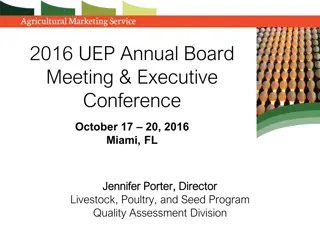USDA Tribal Relations and Federal Policy in Native Agriculture
Explore the role of the USDA Office of Tribal Relations and the USDA Tribal Advisory Committee in addressing barriers and federal policies impacting tribal agriculture. Learn about tribal eligibility, statutory requirements, and the historical eras of federal Indian policy affecting Native American
1 views • 36 slides
Notification of Ministry of Public Health on Novel Food Regulations
This notification outlines the Ministry of Public Health's regulations on novel foods, including definitions, requirements, and examples. It also discusses food categories such as food supplements and special purpose foods, highlighting the importance of health-conscious consumer trends and the pote
2 views • 23 slides
Streamlined Forecasting for Future USDA Foods Utilization
Cathy Sparks, National Commodity Director, discusses the importance of communication in the forecasting process for USDA foods. Tools like the ProcessorLink calculator and K12 On Target planner help processors and distributors estimate quantities needed for production. Commodity Planning Made Easy s
1 views • 9 slides
USDA Accessible Communications Program Overview
Advancing access and equity for individuals with disabilities is a key focus of the USDA Accessible Communications Program. Through initiatives like the National Disability Employment Awareness Month events and implementing the Rehabilitation Act, the program aims to promote accessible communication
7 views • 28 slides
Effective USDA Foods Procurement and Forecasting Strategies
Managing USDA Foods procurement involves analyzing historical data, estimating future trends, and streamlining menu planning to save time and reduce costs. Standardized recipes and inventory management are crucial for efficient operations. Understanding the location and value of USDA Foods, along wi
9 views • 11 slides
Organic vs Conventional Farming: An Overview
In the debate between organic and conventional farming, both methods have their pros and cons. While organic foods are perceived to follow stricter safety standards, both types meet FDA and USDA regulations. They offer similar nutritional value, but organic farming tends to have lower efficiency due
0 views • 6 slides
Genetically Engineered Foods: Perspectives and Insights
FDA ensures the safety of genetically engineered (GMO) foods, EPA reviews their environmental impact, farmers benefit from improved crop management, some consumers prefer non-GMO products, and nutritionally, GM foods are similar to non-GM. While scientific consensus supports the safety of GMOs, glob
1 views • 6 slides
USDA In-Person Sign Language Interpreting Services Training Overview
This training session provides essential information for USDA employees on requesting in-person and virtual sign language interpreting services in the National Capital Region. It covers policy reviews, training completion, requesting procedures, and resources available through the USDA NCR Sign Lang
0 views • 23 slides
Promoting Sustainable Local Foods for Nutrition Security in Nigeria
Food and nutrition insecurity in Nigeria is a pressing issue, prompting efforts to identify and promote locally available, nutritious foods. Stakeholder consultations in Sokoto, Kebbi, and Bauchi States highlighted the importance of staple crops like rice and millet, as well as bio-fortified crops.
0 views • 7 slides
USDA Watershed Programs for Local Communities
USDA Watershed Programs offer assistance in addressing natural resource issues such as flood control, repairing flood damages, and rehabilitating flood control dams. The three major components - Emergency Watershed Program (EWP), Watershed Protection and Flood Control Program (WPFO), and Watershed R
1 views • 15 slides
Thermal Properties of Frozen Foods: Importance and Modeling Equations
Understanding the thermal properties of frozen foods is crucial for ensuring food safety and quality. Dr. J. Badshah discusses the significance of freezing, reduction of microorganism activity, and the role of thermal properties like density, specific heat, and thermal conductivity. Freezing point d
0 views • 15 slides
Dynamic Measurement of Viscoelastic Foods
Viscoelastic foods exhibit time-dependent properties that can be measured using oscillatory mode in viscometers like cone and plate or parallel plate viscometer. The shear stress under oscillating mode provides insights into the material's viscosity and elasticity. Characteristics such as Wissenberg
0 views • 7 slides
Convenience Foods: Processing, Benefits, and Drawbacks
Convenience foods are processed products designed to save time and effort in meal preparation, ranging from frozen and canned goods to ready-to-eat meals. While they offer advantages such as convenience and variety, they also have disadvantages like additives and higher costs. This text explores the
0 views • 15 slides
The MIND Diet for Managing Obesity
Explore the MIND diet, a nutrition plan to support weight management by emphasizing brain-healthy foods. Learn about recommended foods like leafy greens, berries, nuts, olive oil, whole grains, fish, beans, and poultry, along with foods to avoid. This diet promotes cognitive health while addressing
0 views • 13 slides
Overview of Child and Adult Care Food Program (CACFP)
The Child and Adult Care Food Program (CACFP) is a federally funded program aimed at subsidizing eligible institutions to provide nutritious meals to children and adults, promoting lifelong healthy eating and physical activity habits. Administered by the USDA and implemented by various programs, CAC
0 views • 21 slides
Guidance for Complementary Feeding in Infants
After 6 months of age, breastfed infants may struggle to meet their nutrient needs from milk alone, necessitating the introduction of complementary foods. Implementing guiding principles can help ensure optimal nutrition and growth, including exclusive breastfeeding for the first 6 months, practicin
0 views • 18 slides
Healthy Nutrition Choices
Healthy foods include a variety of nutrient-rich options such as fruits, vegetables, whole grains, lean proteins, and low-fat dairy products. Carbohydrate foods can be found in sources like fruits, whole grains, and legumes. Protein-rich foods include meat, fish, poultry, dairy, and plant-based prot
0 views • 14 slides
USDA Pesticide Data Program Overview
The USDA Pesticide Data Program (PDP) provides high-quality pesticide residue data for US foods to support regulatory decision-making and ensure food safety. Through cooperative agreements with participating states, the program conducts sampling of various commodities, including fresh fruits and veg
1 views • 17 slides
Overview of USDA Foods Programs and Delivery Methods
The USDA Foods Programs offer various initiatives like Direct Delivery, Diversion/Processing, DoD Fresh Fruit and Vegetable Program, and Unprocessed Fruit and Vegetable Pilot. These programs provide schools with access to a wide range of food products procured through different methods, including bu
2 views • 10 slides
Overview of USDA Food Distribution Program
The USDA Food Distribution Program aims to support American agricultural markets and provide nutritious food to schools. With over 17 million entitlements distributed annually, the program ensures that USDA foods are domestic and meet nutritional goals. Service fees cover various administrative cost
1 views • 15 slides
Glycaemic Index in Nutrition and Health
Glycaemic Index (GI) measures how carbohydrate-containing foods affect blood glucose levels. High GI foods raise blood glucose rapidly, while low GI foods release glucose gradually. Studies track impacts on blood glucose levels, insulin secretion, fat storage, and pancreatic function. High GI foods
0 views • 15 slides
Functional Foods for Health Benefits
Functional foods are dietary components consumed primarily for health reasons, providing benefits beyond basic nutrition. Types of functional foods include beans, berries, cruciferous vegetables, and cocoa products. Beans contain saponins that may help protect against cancers and lower cholesterol l
0 views • 24 slides
Food Processing and Leftovers: Understanding Preservation Techniques
Food processing plays a crucial role in preserving and extending the shelf life of foods. This chapter explores the advantages and disadvantages of food processing, the conditions microorganisms need to grow, various methods of food preservation, guidelines for freezing food, the significance of bla
0 views • 33 slides
Effective Communication Strategies on GM Foods in Australia
Sasha Tait from FSANZ addresses the challenges faced in communicating with Australian consumers on GM foods due to values-based opposition. The country's transparency initiatives include public consultations and responses, increasing awareness. Social media presence allows direct communication. Usin
0 views • 10 slides
Indiana 4-H Foods Project 2015 Overview
Indiana 4-H Foods Project 2015 aims to promote healthy food choices and habits among youth. The project includes fun activities like basic food prep, trying different foods, and conducting experiments. Various activity guides are structured based on grade levels and cover topics such as healthy food
0 views • 14 slides
Managing USDA Food Receiving and Inventory Basics
Learn about the processes involved in receiving USDA foods, managing inventory using FIFO, understanding storage conditions, determining expiration dates, and interpreting best-if-used-by dates. Ensure proper handling and storage to maintain food quality and safety.
0 views • 15 slides
USDA Foods Ordering Overview: Direct Delivery and Diversion Process
This overview provides detailed information on the USDA Foods Ordering process, focusing on Direct Delivery and Diversion options. Learn about ordering breakdowns, timelines, reminders, and programs like DoD Fresh Fruit and Vegetable. Understand the steps to order in advance, schedule deliveries, se
0 views • 13 slides
Responding to Child Nutrition Programs in Disasters
Learn how Child Nutrition Programs can effectively respond to disaster situations, including utilizing USDA Foods and programs like CACFP, SFSP, and D-SNAP. Discover methods, preparation steps, types of declarations, sources of USDA Foods, and inventory management strategies for efficient disaster r
0 views • 27 slides
Identifying USDA Grade for Exterior Egg Shell Quality
This content presents images of individual eggs and asks users to place the USDA grade for each egg's exterior shell quality. The images provide a visual assessment challenge for viewers to gauge shell quality based on USDA standards.
0 views • 15 slides
USDA Foods Purchases and Certification Updates
The document highlights the USDA's food purchases over the fiscal years, as well as updates on AMS grading and certification processes. It includes information on biosecurity measures, sampling rate revisions, and vigilance protocols. The data reflects purchases of shell eggs, dried eggs, and egg pr
0 views • 11 slides
USDA Foods Program Overview: School Lunch Program Details
Schools and agencies participating in the National School Lunch Program can receive USDA Foods, with entitlement rates set annually by the USDA. The program includes direct and processed options, along with specific delivery schedules and administrative fees. Ordering takes place once a year, with o
0 views • 19 slides
Overview of LT Foods: Market Performance, Business Operations, and Future Potential
LT Foods, a prominent player in the packaged rice processing and export industry, boasts a strong brand portfolio including Daawat. With a focus on branded sales growth, reduction of debt, and product diversification, LT Foods is strategically positioning itself for future success. Recent developmen
1 views • 11 slides
Fascinating World of Fermented Foods and Microorganisms
Unveil the intricate world of fermented foods, delving into the principles, microorganisms, and starter cultures involved. Discover the fine balance between spoilage and fermentation, the general properties and benefits of fermented foods, and the evolution of the fermented foods industry across tim
0 views • 16 slides
USDA New Meal Pattern Guidelines Implementation Overview
The USDA has introduced new meal pattern guidelines effective from October 1, 2017, impacting various food components like Vegetables and Fruits, Grains, Meat and Meat Alternatives, Fluid Milk, Food Preparation, and Additional Provisions. The guidelines aim to promote healthier eating habits by rest
0 views • 10 slides
Exploring Types of Convenience and Processed Foods
Convenience and processed foods offer time-saving benefits, ease of storage, and convenience for meal preparation. They come in various forms such as canned/bottled, frozen, and dried foods, each with specific advantages and preparation methods. Understanding these types of foods can help in making
0 views • 17 slides
USDA Office of the Chief Scientist Overview
The USDA Office of the Chief Scientist (OCS) plays a crucial role in facilitating scientific coordination and collaboration across USDA agencies. It comprises a structured organizational setup with key positions dedicated to scientific integrity, communication, and coordination. The Acting Chief Sci
0 views • 12 slides
USDA Fleet Card Program Usage Procedures
The United States Department of Agriculture (USDA) outlines the procedures and guidelines for using the USDA-authorized Wright Express (WEX) Fleet Card for fuel, maintenance, and repair services for USDA-owned and commercially-leased vehicles. The program covers specific authorized uses such as fuel
0 views • 12 slides
USDA Office of Technology Transfer Patent Program Overview
USDA Office of Technology Transfer's Patent Program provides professional services for creating, managing, and convening Utility Patent Review Committees, preparing and prosecuting U.S. patent applications, advising on patent policies, and facilitating foreign filings. The process for protecting USD
0 views • 24 slides
USDA Foods State Processing Agreements in Oregon
The Oregon Department of Education works with state distributing agencies and school districts to leverage USDA Foods and convert them into convenient end products through processing agreements. Various levels of government can make regulations regarding nonprofit food service accounts, ensuring com
0 views • 13 slides
USDA Foods Program Processing & Benefits
Processing and Diversion in the USDA Foods Program to convert bulk USDA Foods into more convenient forms, understand the possible benefits, and methods like value-pass-thru, Fee for Service, Net-Off-Invoice, and Rebate. Learn how to process and the timeline involved.
0 views • 23 slides







































